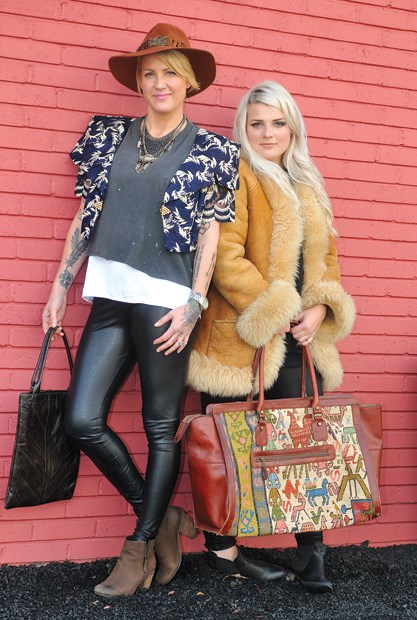For vintage clothing lovers, the thrill of the hunt can be just as exhilarating as finally snagging that 1960s tweed bolero jacket.
But the thought of sifting through rack after rack of musty denim at the neighbourhood thrift shop in order to find that diamond in the rough is off-putting for plenty of wannabe retro clothing wearers. And if you do happen to find a fringed hippie-era crochet vest in like-new condition, how do you wear it without looking like a time traveller?
West Vancouver fashion stylist Lisa Relling is passionate about all things vintage - so much so that she and her niece Mitka Johnston co-founded an Etsy shop this past summer called The Brave Arrow that curates and sells vintage clothing and accessories. They have some advice for vintage virgins when it comes to buying and wearing the fashions of decades past.
North Shore News: I hear the word "vintage" used a lot these days. What exactly is vintage clothing and how is it different from used clothing?
Lisa Relling: Vintage denotes something special, an item that has withstood the test of time and has proven to remain relevant for any number of reasons. Timeless style, quality, historical or cultural significance, designer importance or having an interesting history makes a piece relevant.
Vintage generally refers to clothing that was made before the 1980s, however, as we head further into this century, the '90s are slowly leaking their way into what we consider vintage.
Because the awareness, demand and acceptance of vintage have increased dramatically since the early 1990s, so has the value.
NSN: My aunts won't let me raid their closets! Where is the best place to buy vintage clothing?
LR: There are fabulous finds and dismal duds from every period, and how you decide where to find your treasures is all in the details! These details include fabric, style, brand name (if a label is still available) and design.
Because a great deal of vintage pieces are not labelled, quality of fabric and the condition of a piece becomes important when purchasing vintage. Both online and brick-and-mortar stores are excellent choices for the "vintage virgin." But we suggest being cautious if you are new to buying vintage when shopping at a thrift store. It can be overwhelming and confusing, but the thrill of the hunt is what makes some people swoon!
If you decide to buy online, read the description thoroughly and if you are unsure of the garment's condition, ask the seller. They should be able to help you determine if it's something you want to purchase or not. And don't forget to check a seller's feedback reviews so you know exactly what kind of quality you will be purchasing.
NSN: I don't know where to start. What qualities should I be looking for? Is there anything I should avoid?
LR: Ultimately, we feel that buying vintage clothing is about choosing what makes your heart sing. That, and a little background knowledge of the styles you like and knowing where to look comes in handy.
Condition is of extreme importance. Look for fabrics that have strength and integrity and garments that are in good shape without the need for any difficult alterations. Stay away from synthetic fabrics - '70s polyester is not your friend! We also suggest being militant about stains and avoiding pieces that look too costume-y. For example, extra wide lapels and huge shoulder pads are among the pieces that people will most likely not be able to integrate with their modern wardrobe.
Focus on wearable and easily integrated items that will give you a more modern look and make it so much easier to incorporate your vintage finds.
NSN: Vintage pieces can be pricey. Why should I invest money in a pre-owned garment over something brand new?
LR: Because it is probably made better. A general rule of thumb, especially for higher-end designer pieces, is that the older the piece is, the higher the quality. There is usually more handwork, more attention to detail and a tendency for durability that you don't see that much anymore in modern fashion. Not to mention that with a vintage item, you likely won't spot anyone else on the street wearing that same jacket or carrying that same purse! Part of the fun of buying and wearing vintage is the garment's story. We love thinking about who has owned it before and imagining where it has been and what it has witnessed. Things like this really add to the value of the garment in our eyes.
NSN: I tried on a dress from the 1950s and felt like I was wearing a costume. How can I incorporate vintage clothing and accessories into my wardrobe while retaining my modern style?
LR: We feel that being able to mix current fashions with vintage is the easiest way to begin wearing vintage.
For example, sequined pieces are a big trend currently, but we know that when most women see a heavily sequined jacket they probably think of an elderly woman playing slots in Vegas. So we say pair something like this with a simple white T-shirt, a baggy pair of boyfriend jeans and heeled booties for a current, on-trend look that stands out in a crowd.
Head-to-toe vintage styling is a more difficult way to incorporate vintage pieces into a wardrobe and a sure way to miss the mark with being vintage savvy.
Vintage dressing is about expressing yourself and having fun with fashion. Stand out! Be unique! It's only fashion after all.



